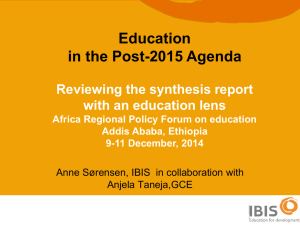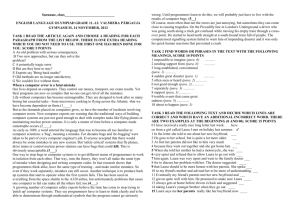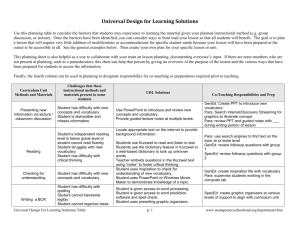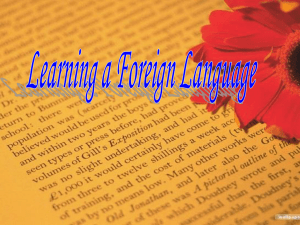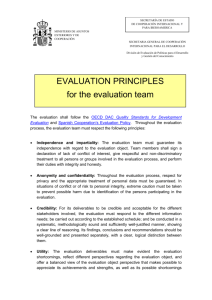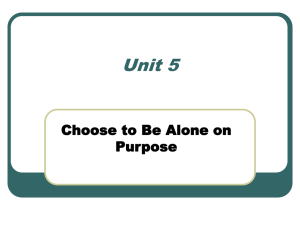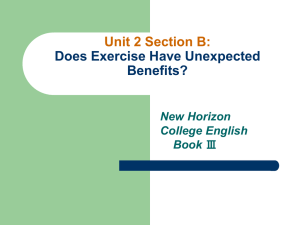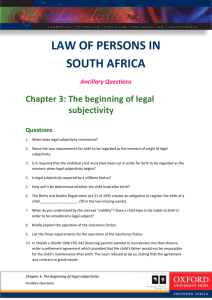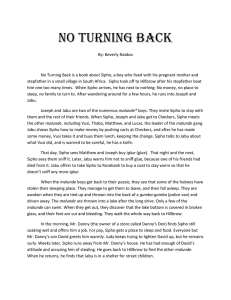Questions
advertisement
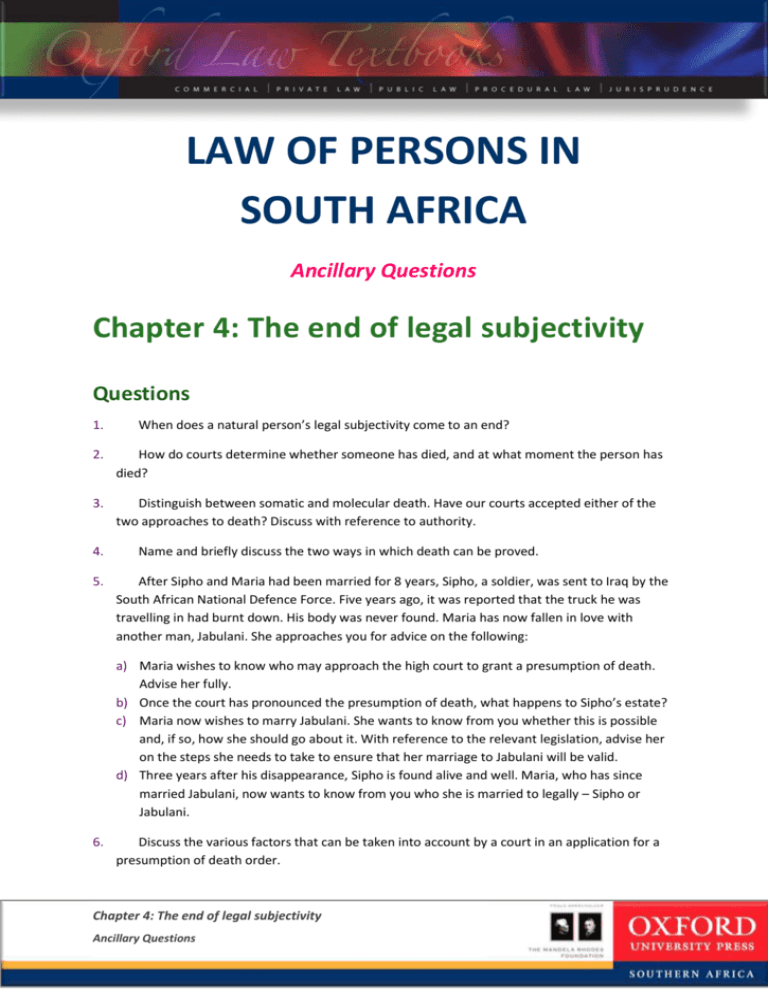
LAW OF PERSONS IN SOUTH AFRICA Ancillary Questions Chapter 4: The end of legal subjectivity Questions 1. When does a natural person’s legal subjectivity come to an end? 2. How do courts determine whether someone has died, and at what moment the person has died? 3. Distinguish between somatic and molecular death. Have our courts accepted either of the two approaches to death? Discuss with reference to authority. 4. 5. Name and briefly discuss the two ways in which death can be proved. After Sipho and Maria had been married for 8 years, Sipho, a soldier, was sent to Iraq by the South African National Defence Force. Five years ago, it was reported that the truck he was travelling in had burnt down. His body was never found. Maria has now fallen in love with another man, Jabulani. She approaches you for advice on the following: a) Maria wishes to know who may approach the high court to grant a presumption of death. Advise her fully. b) Once the court has pronounced the presumption of death, what happens to Sipho’s estate? c) Maria now wishes to marry Jabulani. She wants to know from you whether this is possible and, if so, how she should go about it. With reference to the relevant legislation, advise her on the steps she needs to take to ensure that her marriage to Jabulani will be valid. d) Three years after his disappearance, Sipho is found alive and well. Maria, who has since married Jabulani, now wants to know from you who she is married to legally – Sipho or Jabulani. 6. Discuss the various factors that can be taken into account by a court in an application for a presumption of death order. Chapter 4: The end of legal subjectivity Ancillary Questions 7. Mr Mthembu has been missing for 20 years. A magistrate holds an inquest into Mr Mthembu’s disappearance and makes a finding in terms of section 18 of the Inquests Act 58 of 1959 presuming Mr Mthembu dead. This finding is confirmed by the High Court. Mrs Mthembu now wishes to get married. With reference to authority, advise her whether her marriage would be valid. 8. Distinguish between the burden of proof in the case of presumption of death applications in terms of common law and the Inquests Act. 9. What do you understand by the concept commorientes? 10. How will the courts determine the moment of death of persons who die more or less simultaneously in the same disaster? 11. Who is obliged to report the death of a person who died of natural causes? Refer to authority for your answer. 12. Who is obliged to report the death of a person suspected to have died as a result of unnatural causes? 13. Who is obliged to report the death of a stillborn baby? 14. How will the courts deal with conflict between the heirs on the funeral or cremation arrangements or burial place of a deceased? 15. Briefly discuss the provisions of the Human Tissue Act 65 of 1983 that regulate the use of parts of the human body for therapeutic and scientific purposes. Answers 1. A natural person’s legal subjectivity comes to an end at the moment of his or her death (para 4.1). 2. Courts rely on medical evidence to determine whether someone has died, and at what moment the person died (para 4.1). 3. Somatic death occurs with the permanent cessation of the functions of the vital nerve centres of the brainstem, and the individual ceases to exist as a functional whole. After somatic death other cells in the body, such as the heart and eyes, can continue functioning but they will gradually undergo irreversible changes until molecular death sets in. Students should then discuss the decision in S v Williams 1986 (4) SA 1188 (A), and come to the conclusion that the question of which approach to death is legally acceptable was left open. Therefore, our courts have not yet accepted either of the two approaches to death (para 4.1). Chapter 4: The end of legal subjectivity Page 2 of 4 4. 5. The two ways in which death can be proved (death certificate and direct evidence) is discussed in para 4.2.1 & 4.2.2. Answers as follows: a) Any person who has an interest in the death of a missing person can apply to the High Court that has jurisdiction over the area where the missing person was domiciled at the time of his or her disappearance for an order presuming the death of the missing person (para 4.3.2.1). b) The consequences of the presumption of death order are discussed in para 4.3.4. c) The provisions of the Dissolution of Marriages on Presumption of Death Act 23 of 1979 are discussed in para 4.3.4. d) The consequence of a successful application in terms of the Dissolution of Marriages on Presumption of Death Act is that the marriage or civil union is for all purposes deemed to have been dissolved by death. The necessary implication of this is that even if the missing person were to reappear, the marriage or civil union will remain dissolved (para 4.3.4). 6. See para 4.3.2.2 in this regard. 7. If an inquest was held and a finding was made in terms of the Inquests Act, which finding was confirmed by the High Court, the missing person’s marriage or civil union is deemed to have been automatically dissolved as from the date determined by the court as the date on which the person died. In these cases no special application need be made for the dissolution of the marriage or civil union (para 4.3.4). 8. The Inquests Act provides that the magistrate must be certain beyond reasonable doubt that the person is dead before he or she may record a finding that the person is presumably dead, whereas a presumption of death may be granted in terms of the common-law procedure if it is proved on a balance of probabilities that the person is dead (para 4.3.3). 9. Commorientes are persons who die more or less simultaneously in the same disaster (para 4.4). 10. The moment of death of commorientes is a question of fact. In the event of a lack of evidence to prove the contrary, a court will make an order that the persons died simultaneously (para 4.4). 11. In the case of a death due to natural causes, this duty rests on any person present at the death, or who became aware of the death, or who is in charge of the deceased’s funeral (Births and Deaths Registration Act 51 of 1992 s 15(1)) (para 4.5). 12. 13. See para 4.5 in this regard. The medical practitioner who was present at the stillbirth or examined the stillborn child’s body must notify the Director-General of the stillbirth. If no medical practitioner was present at Chapter 4: The end of legal subjectivity Page 3 of 4 the stillbirth or examined the child’s body, anyone who was present at the child’s stillbirth must notify the Director-General (Births and Deaths Registration Act s 18(2)) (para 4.5). 14. 15. It has been held that in the case of conflict between the heirs on the funeral or cremation arrangements or burial place, the surviving spouse has a “paramount” right to decide on these issues. However, this principle is not applied consistently. In some divisions it has been held that the court should consider various factors, including the deceased’s family relationships and the wishes of the surviving spouse. Students should refer to the decision in Mahala v Nkombombini 2006 (5) SA 524 (SEC) in this regard (see para 4.6 in this regard). See para 4.7 in this regard. Chapter 4: The end of legal subjectivity Page 4 of 4


